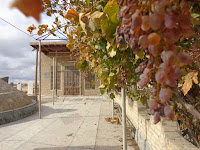I don't want to imply that Tashkent is limited touristically, but during my last trip to Uzbekistan, we hit most of the city's highlights in terms of monuments and markets. And besides, most of the places that make the country a travel destination are located outside the capital. So during my second trip to the country, we spent a short day in Tashkent before flying to Bukhara, a UNESCO World Heritage site. This dreary time of year doesn't draw many tourists, so it seemed we were the only guests at Boutique Hotel Amelia (left), which put out quite a spread for the included breakfast, served in a 19th-century Jewish merchant's home (right).
We arrived after dark, but the city was still full of light, especially in the main square, Lyab-i-Khauz, where a spotlight on Nadir Divan-begi Khanaka creates a clear reflection of the Sufi dervish building on the water basin below (top left). Other structures in the square cast shadows on sedan sitting in front of the Kukeldash Madrasa, the largest in Central Asia (top right). The moon was out, but most of the light was coming from Bolo Hauz Chaikhana, situated catty-corner to the dervishes' home and across from some stone camels (bottom).
In the daylight, the sculptures were a prime backdrop for photographers shooting newlyweds -- and tourists taking selfies (left). But I was more interested in the memorial to Khoja Nasruddin, the Don Quixote of the Middle East, who is known far and wide for his foolish wisdom (right).
The colors of the night continued into the day as we toured around the town. Inside the khanaka, a vivid collection of artifacts, uncovered from nearby digs, is housed under a kaleidoscopic ceiling (left). Across the reservoir, the Nadir Divan-begi Madrasa displayed its chromatic construction on the outside (right). The converted caravansary, like the khanaka, is named after the vizier who oversaw their creation; I, for one, think good ol' Nadir defied his name when it came to design taste.
Azure architecture abounds in the city, especially within one of its main tourist sites: the Po-i-Kalyan complex, dominated by the Kalyan Minaret, the tallest in Central Asia, also known as the Tower of Death because criminals were reportedly once tossed from its windows (top). From Mir-i Arab Madrasa, still functioning after its 16th-century start, one can look across Registan Square toward Kalyan Mosque, rebuilt on the site where its predecessor was burned during the 13th-century Mongolian invasion (bottom left). Down the street from the square are a grouping of trading domes and two madrasas, Abdullazizkhan and Ulugbek, facing each other. The madrasas are now filled with more souvenirs than students -- but at least one stork, a prominent symbol of peace in Uzbekistan, has taken roost on one of Abdullazizkhan's towers (bottom right).
Another prominent structure on the Bukhara skyline is the Ark Fortress, former home to the region's ruling khans (top left). The citadel once contained an entire city, but now only a few buildings are accessible, including the emir's throne room and mosque, which houses an exhibit on ancient publications (top right). While schoolgirls synchronized selfies, I choreographed the appropriate angle to capture TJ in one of the mosque's ceiling mirrors (bottom).
Not all of the history in Bukhara is imbued with grandeur. Near Lyab-i-Khauz and next to Maggoki-Attari Mosque rest the footprints of commoners' caravaseries, which continue to be excavated to deeper levels (left). Farther afield we found the Jewish cemetery (right), which felt like an anachronism, considering we couldn't locate the once-flourishing synagogue, which apparently now has a dwindling population.
Although they come straight out of Soviet times, the ubiquitous Chaikas and Volgas hardly seem out of style. Perhaps they've stood the test of time because they are so sturdy, judging by the load we saw on one parked at the furniture market (top left), conveniently located across from the jewelry market. Near the city's produce market, right next to the saintly Chashma-Ayub Mausoleum, many vehicles were stacked high with sundries (top right). Just a short stroll away from the bustling commercial center, the city walls crumbled without a care (bottom).
I, of course, care a lot about food, so we did sample the local specialties. On the night we arrived, TJ and I shared some draft beers and apricot kernels -- which either fight or cause cancer, depending on which internet wisdom you believe -- at a hole-in-the-wall called The Pub (left). The next night, we had a more substantial meal, including Uzbek dumplings manti, at Chinar Chaikhana (right).
After finishing our chaikhana victuals, we had just a bit of moonlight left to take a look at Char Minar, the gatehouse of a now-missing madrasa (left), before catching a cab to our return flight. The fading colors put a nice capstone on our trip, which started with a stunning sunset that only hinted at the hues and tints we would encounter (right).
























No comments:
Post a Comment